After triumphing in two major tournaments, in London in December and in Wijk aan Zee in January, Magnus Carlsen is a clear favorite to win the eight-player Candidates event in London (March 15-April 1). The world's top-rated player is the only Western-born competitor in the field, all his opponents having been born in the Soviet Union. The winner of the double-round robin will play in the world championship match against the titleholder Vishy Anand. Why should Carlsen win?
Let's have a look at his recent victory at the 75th Tata Steel Chess tournament in the Dutch coastal town of Wijk aan Zee.
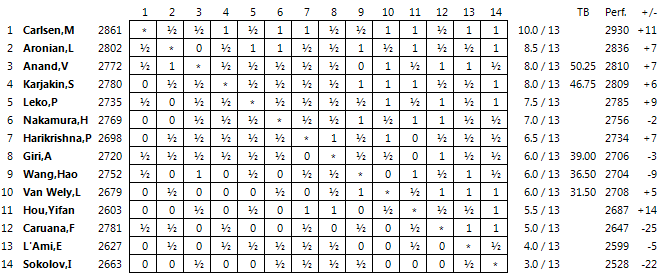
After seven rounds Carlsen was neck and neck with the world Champion Vishy Anand, both at 5/7. But in the last six rounds with a magnificent burst of energy the Norwegian grandmaster scored five points and pulled away from the field.
He broke two records: moving his rating still higher to 2872 on the February 2013 FIDE list, 62 points ahead his nearest rival Vladimir Kramnik. The other was personal: he was undefeated and won seven games, matching Garry Kasparov's Wijk aan Zee record from 1999. Carlsen has never finished with plus seven in a major tournament before.
Acquiring the Danish grandmaster Pieter Heine Nielsen as a coach will certainly help Carlsen to impove his opening play, perhaps the weakest stage of his game. This is important because many of Carlsen's opponents are known for their thorough opening preparation. Nielsen, who helped Vishy Anand to win four world titles, brings in a lot of experience.
However, Carlsen shines in the middlegame and endgame. That's where the fun begins for him and sets him apart from the rest. He plays with great determination, exploiting every possible chance to win. "I was happy I got the maximum out of every game," he said in Wijk aan Zee. Not everybody is capable of playing like this every single game. He is cool under pressure and very patient.
He gave the impression in Wijk aan Zee that he was bored to play the same openings over and over. But Carlsen was clearly capable to punish unsound opening play. The U.S. champion Hikaru Nakamura not only ignored dr. Tarrasch dictum about bad prospects of a knight on the rim, he put both horses at the edge of the board, allowing Carlsen to build a decisive space advantage.
"It was one of my better games," said Carlsen. "I faced some fresh problems on the board , but I dealt with them pretty confidently. It wasn't Nakamura's best day."
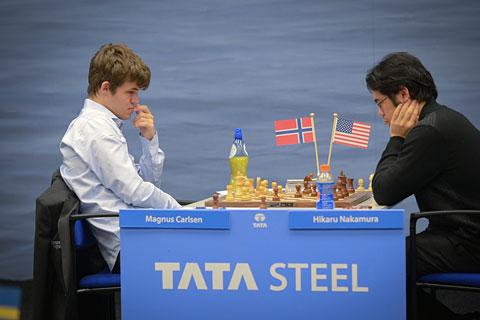
Carlsen,Magnus - Nakamura,Hikaru
Wijk aan Zee 2013
1.e4 c5 2.Nf3 Nc6 3.d4 cxd4 4.Nxd4 e5 5.Nb5 d6
You can expect almost anything from Nakamura in the opening. This line is called the Kalashnikov Sicilian and the joker who came up with that name obviously wanted to please the National Rifle Association. It is the only machine gun among chess openings. But it is not the essence of this line. Black wants to contest white on the square d5 with Ng8-e7. It also leaves his f-pawn free to strike in the center with f7-f5.
6.g3
White usually contains black in the center with 6.c4 but Carlsen wants to do the same from the diagonal h1-a8. The innocently looking fianchetto move was mastered by the English GM John Nunn more then two decades ago when he was in his prime and without grey hair, and Carlsen knew of it.
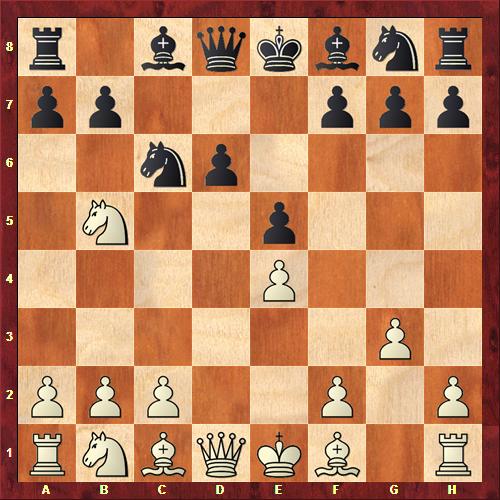
6...h5
Carlsen suspected that Nakamura could play this move: "It's reasonable," Magnus said. "I would take it from there." But black could have switched gears and play 6...Nf6 7.Bg2 Be7 quickly developing the kingside.
7.N1c3 a6 8.Na3 b5
The game Nunn-Short,Wijk aan Zee 1990, continued: 8...h4 9.Bg2 h3 10.Bf1 b5 11.Nd5 Nce7 12.Bg5 f6 13.Be3 Nxd5 14.Qxd5 Rb8 15.0-0-0 Ne7 16.Qxd6 Qxd6 17.Rxd6 Nf5 18.Rb6 Rxb6 19.Bxb6 Nd6 20.f3 Be6 21.Bc5 Be7 22.Be2 Nb7 23.Bxe7 Kxe7 24.b3 Nd6 25.c3 g6 26.Nc2 a5 27.Rd1 f5 28.exf5 gxf5 29.Bf1 f4 30.gxf4 exf4 31.Nd4 Bd7 32.Ne2 Bc6 33.Nxf4 Bxf3 and black resigned.
9.Nd5 Nge7 10.Bg2
Carlsen thought that he had too many weaknesses on the kingside to play 10.c4.
10...Bg4
Exchanging in the center 10...Nxd5 11.exd5 Ne7 was better according to Carlsen, but after 12.c3 followed by 13.Nc2 and break with a2-a4 or f2-f4 white clearly dictates the play.
11.f3 Be6
Carlsen expected 11...Bd7 and after 12.c3 black can take on d5 with the knight 12...Nxd5 13.exd5 Ne7, although white still has the edge after 14.Nc2 h4 15.f4.
The Norwegian grandmaster considered 12.c4 Nxd5 13.cxd5 Nd4 14.Be3 h4 15.0-0.
12.c3 h4 13.Nc2 Bxd5
Surrendering a bishop pair and the control of the light squares. After 13...h3 14.Bf1 black is done on the kingside and white has a space advantage and can attack the vulnerable pawn on b5 with a2-a4.
After 13...Na5 comes 14.Nce3.
14.exd5 Na5 15.f4 Nf5?!
A bit provocative. Carlsen thought that 15...hxg3 16.hxg3 Rxh1+ 17.Bxh1 Qd7 18.Bg2 exf4 19.Bxf4 Ng6 20.Be3 Be7 was better. At least, black can develop the king side.
16.g4!
Forcing the black knight to the edge.
16...h3 17.Be4 Nh4
The queen check is not dangerous: 17...Qh4+ 18.Kf1 Ne7 [Or 18...Nh6 19.Rg1.] 19.Qe2 with white's advantage.
18.0-0
Carlsen thought that he was much better. All his pieces are in play.
18...g6 19.Kh1 Bg7
There was no reason to prevent 19...f5 20.Bd3 e4 21.Be2 followed by a2-a4, white is clearly better.
20.f5!
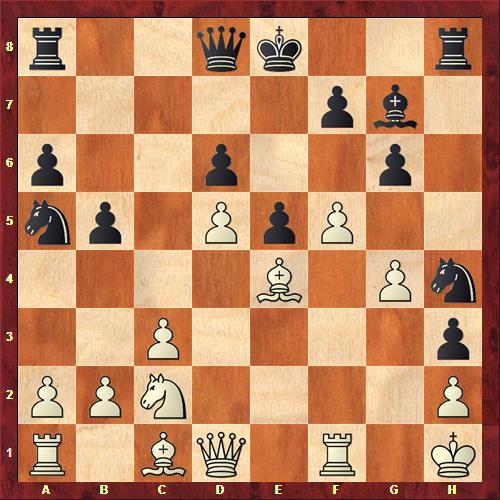
20...gxf5 21.gxf5!?
Limiting the knight on h4, although some computer programs prefer 21.Bxf5.
21...Ng2
Allowing further stifling of black pieces, but 21...Bf6 22.Nb4 Qb6 23.a4 is in white's favor.
22.f6!
Carlsen thought that Nakamura might have overlooked this resource.
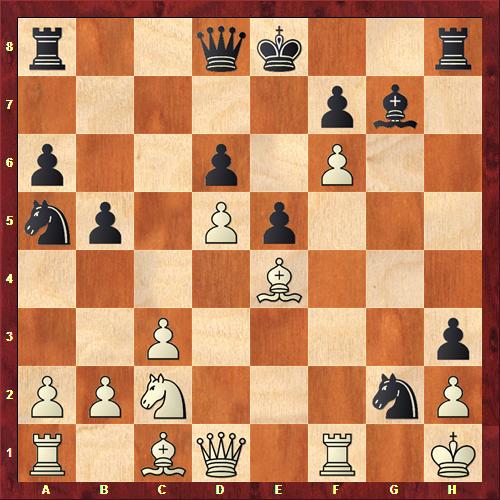
22...Bf8
Giving up the exchange 22...Bxf6 23.Qf3 Rh4 24.Bg5 Rf4 25.Bxf4 Nxf4 does not help. After 26.b3 white eliminates the knight on a5. Although he has one nice piece, the knight on f4, he hasn't much else going for him. - Carlsen
After 23...Nf4 24.Bxf4 exf4 25. Qxf4 Qe7 26.Qxf6! Qxe4+ 27.Rf3 Kd7 28.Qxf7+ Qe7 29.Re1 white wins.
23.Qf3
White dominates. It's not much fun for black.
23...Qc7 24.Nb4 Nb7 25.Nc6 Nc5 26.Bf5 Nd7 27.Bg5 Rg8
After 27...Nb8 28.Nxe5! dxe5 29.d6 Qa7 30.Be4 white wins.
28.Qh5 Nb6 29.Be6!
Threatening 30 Ne7 with a decisive attack of the pawn on f7. The black king is encircled.
29...Rxg5
There is no hope. White wins either after 29...Qb7 30.Ne7; or after 29...Nf4 30.Rxf4! exf4 31.Bxf7+ Qxf7 32.Re1+.
30.Qxg5 fxe6
After 30...Nf4 31.Rxf4! exf4 32.Qh5 Nc4 33.Rg1 Ne5 34.Nxe5 dxe5 35.Rg8, threatening 36.Rxf8+, white wins.
31.dxe6
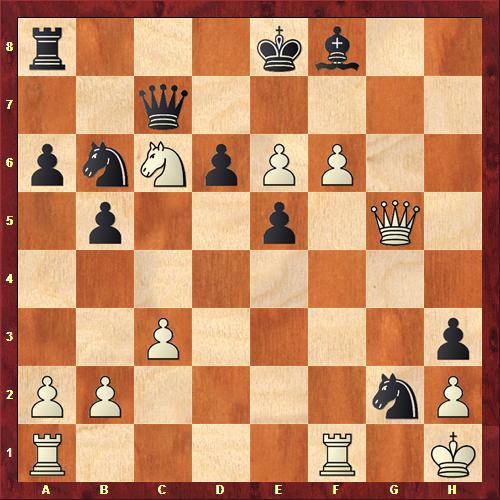
After 31...Qxc6 32.f7 mates.
Black resigned
Note that in the replay windows below you can click either on the arrows under the diagram or on the notation to follow the game.
Image by Frans Peeters
